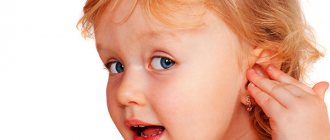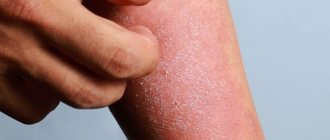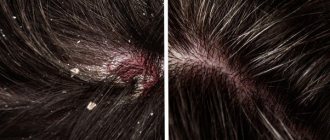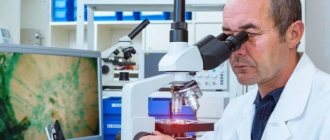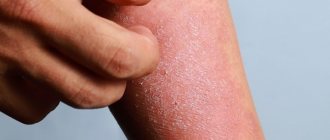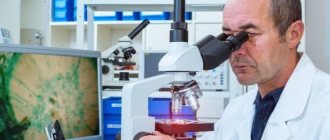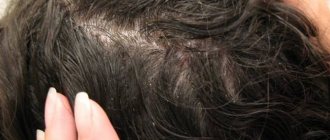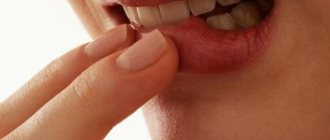When the sebaceous glands on the scalp become inflamed, a person develops seborrheic dermatitis or seborrhea. The disease is caused by pathogenic fungi that become active under stress, poor diet or hormonal imbalances. For treatment, special medications, shampoos, folk remedies are used, and a rational diet is selected.
Main causes of seborrheic dermatitis
Opportunistic microflora is constantly present on human skin. It includes lipophilic yeast fungi of the genus Malassezia. Under normal conditions, the immune system suppresses their growth and spread. But under the influence of certain reasons, they become active, affect the sebaceous glands on the scalp and body, and provoke the development of seborrheic dermatitis.
The opportunistic fungus Malassezia is present on the epidermis and uses skin secretions and acids secreted by the sebaceous glands for development. If fat is produced in increased quantities, it multiplies faster, triggers the inflammatory process, peeling and irritation of the skin.
The main causes of seborrhea:
- diseases of the endocrine system;
- decline in immunity;
- nervous system disorders;
- strict diets with limited proteins and vitamins;
- high levels of androgens;
- heavy physical and sports activity;
- taking drugs based on testosterone, corticosteroids;
- heredity.
Seborrheic dermatitis often occurs against a background of severe stress, depression or neurosis. Difficult situations disrupt the functioning of the immune system and reduce the body's defenses. The problem is aggravated by dysbiosis and intestinal pathologies, in which nutrients, minerals, and amino acids are poorly absorbed.
The disease often develops in patients with immunodeficiency virus, Parkinson's disease, and paralysis of the limbs. The risk group includes people who constantly experience mental and nervous strain, and those who have suffered a spinal injury or brain injury.
Seborrhea is contagious
Seborrhea is not contagious, so you should not avoid communicating with people who have dandruff or seborrhea on their faces. If everything is in order with your immunity and the functioning of the sebaceous glands, then even if fungi of the genus Malassezia come into contact with your skin, nothing will happen. This fungus is already constantly present on your skin without causing problems.
Therefore, neither the use of a common comb, nor a hat, nor a towel threatens your health if you do not have a predisposition to seborrheic dermatitis and a strong immune system. Seborrhea is also not transmitted by airborne droplets, touching the head or shaking hands.
Types of seborrhea
Normally, the sebaceous secretion secreted by human skin becomes a protective barrier of the epidermis. With dermatitis, its amount changes, and characteristic symptoms of inflammation appear. Doctors use them to diagnose pathology, dividing into several main types:
- Dry seborrheic dermatitis. Peeling of the skin causes excessive dandruff, itching and discomfort, and a feeling of tightness. It often occurs at the initial stage of the disease, but develops quickly and provokes active hair loss.
- Fatty. The fungus changes the composition of the skin secretion, which is released in excess of the norm. Accompanied by secondary infections, the appearance of spots on the face, neck, and behind the ears. If the disease is not treated, localized baldness occurs after a few years.
- Mixed. A severe type of disease in which the skin on the face is affected by dry seborrhea, and oily crusts appear on the head, and bacterial infections develop. Accompanied by painful sensations, burning, itching.
One of the subtypes of seborrheic dermatitis is common dandruff, which often becomes a cosmetic problem. It occurs when the lipid balance of the scalp is disturbed, but is easily eliminated and does not require the use of medications.
What is the difference between dandruff and seborrhea?
Ordinary dandruff is a mild form of seborrhea, which, as a rule, does not require treatment, just proper care - using a mild detergent that does not irritate the skin.
In the case of dry seborrhea, skin flakes (dandruff) easily flake off and settle in large quantities on the hair and shoulders. Hair may become thinner and break easily.
If seborrhea is oily, the skin flakes (dandruff) stick together, often sticking to the hair and forming yellowish, greasy crusts. With oily seborrhea, the hair quickly gets dirty, becomes greasy, and often thins.
Manifestations of seborrhea are noted in those places where the sebaceous glands are located: the face, mustache, eyebrows, upper chest, interscapular area and, in fact, the scalp.
Hair also changes with seborrhea, becoming greasy and shiny, it quickly becomes dirty, sticking together in strands.
General symptoms and signs of the disease
In most diagnosed cases, dermatitis occurs during the period of hormonal imbalance in adolescence. In men, the peak incidence occurs between 20 and 40 years of age. For women, the risk of developing seborrhea increases during pregnancy, after childbirth, miscarriage or abortion. The disease is often exacerbated by tumors of the uterus, thyroid gland, and adrenal glands.
There are symptoms characteristic of all types of seborrheic dermatitis:
- the appearance of red spots with a yellow tint on the skin;
- the formation of large blisters covered with fatty scales;
- dense crusts on the head between the hairs;
- cracks and clear discharge from blisters;
- severe itching;
- unpleasant burning sensation.
With dermatitis, a pink rash, black comedones often appear, and the skin becomes rougher and looser in appearance. Hair takes on a stale appearance a few hours after washing.
Causes of occurrence and development
The development of seborrhea and seborrheic dermatitis is based on dysfunction of the sebaceous glands of the skin, which manifests itself in the fact that the glands begin to produce either too little secretion (sebum) or too much, in addition, the composition and consistency of the secretion also changes. Excess secretions are mixed with dust, dead skin cells and can serve as a substrate for the active reproduction of opportunistic microorganisms, most often fungi of the genus Malassezia, which are normally present on the skin of 90% of the population3. The metabolic products of this pathogen cause skin irritation and its inflammatory reaction, manifested in the form of redness and the appearance of papules covered with greasy crusts.
Why does the functioning of the sebaceous glands malfunction? Doctors identify many factors that can play a role in dysfunction of the sebaceous glands. Among them:
- genetic predisposition;
- changes in hormonal levels (increased levels of progesterone and androgens, decreased levels of estrogen - therefore, the disorder is often found in men), including in infancy, puberty, pregnancy, and chronic diseases;
- decreased immunity due to chronic or infectious diseases, taking potent medications;
- a lot others.
The ducts of the sebaceous glands open into the mouth of the hair follicle, so with seborrhea and seborrheic dermatitis, not only the skin, but also the patient’s hair suffers.
The problem may worsen as a result of prolonged exposure to heat or due to increased sensitivity of the skin to external irritants. At the same time, seborrheic dermatitis in children and adults can be severe, regardless of the number of active fungi on the skin.
Localization of dermatitis and features of manifestation
In most patients, seborrheic dermatitis develops on the scalp. In the upper part of the epidermis, sebum secretions accumulate and mix with skin particles. They form dense crusts of a yellow tint. As it progresses, plaques and severe itching appear.
In severe cases of dermatitis, a “seborrheic crown” forms on the head: the area of peeling covers the supra-frontal and occipital areas, extending beyond the ears. It can affect the outer part of the ear canal. The crusts come off poorly, revealing inflamed skin and red spots. Noticeable bald spots appear.
Facial lesion
With seborrheic dermatitis, the pores become clogged, inflamed, and a small red rash appears on the forehead and cheeks. Peeling zones are always symmetrical: they affect the wings of the nose on both sides, nasolabial folds, eyebrows or cheeks. After washing, the face quickly becomes greasy, itching and redness occur.
Often the eyelash growth area and eyelids become inflamed on the face, and allergic conjunctivitis or blepharitis develops. The patient's visual acuity decreases, purulent discharge, redness of the sclera and painful sensations appear. The area around the eyes does not have sebaceous glands, so dry dermatitis is diagnosed.
Manifestation of seborrhea on the body
During an exacerbation, pink spots covered with blisters appear on the skin. They can merge into large formations, peel and itch severely, causing discomfort to a person. As it worsens, weeping eczema often develops with copious secretion of inflammatory exudate.
The manifestation of seborrhea is localized on the body. Redness with a rash appears more often on the chest and back in the area of the shoulder blades, and can spread to the shoulders and merge with lesions on the neck. This is due to the increased number of sebaceous glands and their increased work during illness. The situation worsens when eating foods with a lot of sugar, fatty sauces, and spices.
Scalp dermatitis: problems in the endocrine system and hormonal levels
Changes in the functioning of the hormonal system do not always benefit the body.
In this case, they are expressed in increased proliferation of the fungus.
This phenomenon is due to the fact that it is sex hormones that control the secretion of the sebaceous glands.
Steroids have the greatest effect.
It was found that in women diagnosed with seborrheic dermatitis (eczema) of the epidermis or scalp, the concentration and ratio of testosterone and estrogen are impaired.
Laboratory analysis indicated increased testosterone levels with a simultaneous decrease in estrogen.
A change in the level of androgens in the body, namely their increase, can act as a hereditary disease or be a sign of some pathology.
Diseases that can occur with increased androgen levels:
- congenital adrenal dysfunction
- Stein-Leventhal syndrome
- androsteroma (hormonally active tumor localized in the adrenal gland)
- testicular cancer
- hypercortisolism syndrome
Dermatitis of the scalp is often observed during adolescence in a child.
This is also due to natural hormonal changes.
In female patients, dermatitis more often manifests itself against the background of the onset of menstruation or diseases of the urogenital tract.
Scalp dermatitis: diseases of the central nervous system and autonomic system
In addition to the hormonal background, the nervous system and the autonomic system take part in the secretion of the sebaceous glands.
Thus, many patients with chronic pathologies, for example, excessive sweating or hypotension, experience increased sebum production.
This also applies to the central nervous system; it also takes part in the process of sebum secretion.
A large number of patients with pathologies of the nervous system (neurasthenia, neuroinfections, chronic depression, etc.) show signs of dermatitis.
Diseases that are most often accompanied by increased sebum production:
- parasympathicotonia
- shaking palsy
- encephalitis Economo
- epileptic disorder.
Diagnosis of seborrheic dermatitis
Symptoms often resemble those of psoriasis and other dermatological diseases. Therefore, it is important to conduct in-depth research. It begins with a visual examination and history taking: the dermatologist needs to find out the hidden causes of inflammation of the sebaceous glands, the patient’s eating habits, work and nervous condition.
Among the main diagnostic methods that are prescribed for suspected seborrhea:
- microscopy with examination of the skin;
- dermatoscopy (examination using a special dermatoscope);
- blood chemistry;
- spectral study of skin particles.
In case of secondary infection of wounds, after opening the crusts and blisters, the doctor takes a scraping. It is necessary to identify the type of bacteria or fungi in order to select the correct antibiotic for treatment and establish a final diagnosis.
If the disease is associated with allergies, special tests are recommended to identify the irritant. The main method is to determine high levels of immunoglobulin for pollen, wool, milk protein or food. This eliminates the risk factor, prevents relapse and development of dermatitis into chronic.
With hormonal disorders, the cause of seborrhea is often an increased level of androgens. An endocrinologist prescribes tests, if necessary, ultrasound of the thyroid gland and adrenal glands. In women, the problem can be caused by hidden tumors, so consultation and examination by a gynecologist is required.
Features of treatment
The choice of treatment method depends on many factors: the age and gender of the patient, the form and stage of development of the disease, and the underlying cause. The drugs must work in several directions simultaneously:
- remove cosmetic defects, dryness, crusts;
- protect against secondary infection in cracks and wounds;
- suppress the growth of pathogenic fungi Malassezia;
- relieve burning and itching.
For the treatment of children and adults, drugs with a similar composition are used, but children's products have a reduced concentration of active components. In infants, the cause is often related to diet and allergies, so proper diet, hygiene and care for inflamed skin are of great importance.
During treatment, drugs of several pharmacological groups are used:
- antihistamines;
- antifungal;
- antibiotics;
- antipruritic;
- atopic ointments;
- immunostimulants.
In case of malnutrition and to restore hair growth, vitamin complexes are prescribed. Traditional methods, the use of herbal masks, decoctions and infusions that improve skin condition, have a good effect. They can complement the main therapy with medications, support the immune system and relieve unpleasant symptoms.
Treatment of dermatitis on the scalp
The disease often begins in adolescents at the age of 14-15 when hormonal levels become established. Often, seborrhea on the scalp appears in infants in the first 1-3 months as a reaction to the mother’s diet or artificial formulas, with intestinal dysbiosis. In adults, exacerbation begins after stress.
How and with what to treat inflammation on the head is decided by a dermatologist. To eliminate infection and dandruff, select:
- Medicinal shampoos with an antifungal effect (Ketoconazole, Nizoral, Sebozol).
- Pastes and ointments for application to the scalp, improving the condition of the epidermis (Sulsena, Mycospor).
- Antihistamines in tablets and drops to reduce itching (Zodak, Suprastin, Telfast).
- Immunostimulants for severe and generalized forms (Interferon, Viferon).
With dermatitis, cracks and wounds form on the head, which can become infected. The causes of secondary inflammation are: Staphylococcus aureus, Streptococcus, Pseudomonas aeruginosa. The itching and burning intensify, and suppuration appears under the crusts. For effective treatment, broad-spectrum antibiotics are selected:
- Doxycycline;
- Medomycin;
- Metacycline;
- Unidox.
The doctor calculates the duration of the course individually, based on the patient’s age. For young children, minimal dosages and treatment under the strict supervision of a pediatrician are recommended.
With seborrheic dermatitis, patients actively lose hair. To speed up the awakening of the bulbs, vitamin complexes are recommended:
- Vitacap;
- Alphabet;
- Pantovigar;
- Perfect.
For dermatitis, cosmetic shampoos must be used. They should not contain aggressive additives and components that increase irritation. To enhance the effect, doctors prescribe a course of physiotherapeutic procedures - Darsonval. In combination with ointments and pastes, it alleviates the condition after 1-2 procedures.
Darsonval for seborrhea
Darsonvalization is a method of exposing the scalp to high-frequency currents. They irritate capillaries and sweat glands, stimulating the awakening of hair follicles. During the procedure, the ducts open, skin secretions are released, and inflammation is reduced. For seborrhea, Darsonval helps:
- improve scalp nutrition;
- reduce swelling during inflammation;
- relieve burning and itching;
- accelerate oxygenation of damaged tissues.
The main advantage of the method is that the nutrient medium for pathogenic Malassezia fungi is completely destroyed. The amount of skin secretions that are necessary for reproduction is reduced, and the scalp is cleared of seborrheic crusts. This speeds up the healing and recovery of the patient.
Features of the treatment of dermatitis on the face
At the first manifestations of the disease, doctors prescribe antihistamines to reduce itching. They relieve swelling and redness, help get rid of itching and burning. Within 5-7 days you can take:
- Tavegil;
- Diazolin;
- Cetrin;
- Zyrtec.
For young children, antihistamines are offered in the form of syrups: Claritin, Loratadine. They block the cause of seborrhea, making further treatment more effective and comfortable for the child.
In case of severe inflammation on the face, you cannot do without using hormonal ointments. They contain glucocorticosteroids that block the production of allergens, soothe and relieve irritation:
- Flucicort. Contains betamethasone, fusidic acid, protects against secondary infections. Apply a thin layer 2 times a day, approved for treatment during pregnancy and lactation.
- Akriderm. The composition contains betamethasone and the antibiotic gentamicin, which reduce the activity of fungi and bacteria. Approved for treating inflammation on the eyebrows, nose, hands and feet. Can be prescribed to children from 2 years of age.
- Elokom. Contains mometasone, has an antipruritic effect. It is necessary to rub into the skin on the nose, cheeks, and behind the ears. Can be used in the treatment of children from 2 years of age.
In addition to hormonal ointments, doctors always select healing creams and suspensions. They improve the condition of inflamed areas and start the recovery process. The highest quality non-hormonal ointments for the treatment of seborrhea on the face and body:
- Zinc. An excellent antiseptic with a drying and healing effect. Restores microflora on the epidermis, eliminates oily sheen and normalizes the functioning of the sebaceous glands.
- Salicylic. Contains a beneficial acid that helps fight flaking, dandruff, and excessive secretions of the skin. Tones capillaries, relieves swelling during inflammation.
- Sulfuric. Contains sulfur oxide, quickly destroys Malassezia. Apply a thin layer to the affected areas of the face, but it dries out the epidermis, so it is recommended for oily seborrhea. Combines with moisturizing and nourishing creams to restore lipid balance.
Inexpensive but effective ointments contain natural ingredients that effectively stop the inflammatory process. Can be used after hormonal medications or during the initial stage of the disease.
During treatment, antifungal ointments must be prescribed. They act directly on the causative agent of the disease, suppressing its growth at any stage. For dermatitis, the doctor may prescribe:
- Clotrimazole. The ointment is effective against many types of fungi and is applied to the scalp and face. Helps cope with painful symptoms, begins to act after 1 application.
- Mikoket. A high-quality product is not absorbed into the systemic bloodstream; it is recommended for wounds under crusts. The active substance ketoconazole protects against fungal infection.
- Lamisil. Contains the substance terbinafine, which quickly inhibits the growth of mycotic pathogens. Destroys spores, prevents relapse of seborrhea and candidiasis.
If external skin treatment does not give the desired result, a dermatologist can select tablets with a similar composition. They suppress fungal infection from the inside, accelerating recovery and cleansing the skin of seborrheic crusts.
Treatment of seborrhea
Treatment of seborrhea is selected individually. As a rule, proper care or sebum-regulating agents, as well as external preparations, are sufficient to reduce the activity of Malassezia fungi.
In the case of seborrhea, the following may be additionally prescribed:
- vitamin preparations;
- enterosorbents (for detoxification);
- restoratives.
Types of shampoos for seborrhea
The complex treatment of seborrhea of the head must include a special medicated shampoo, which should not only wash away impurities and excess sebum from the hair and scalp, but also have an antimicrobial and antifungal effect, relieve inflammation, reduce itching and irritation of the skin.
Shampoos against seborrhea are conventionally classified into groups depending on the active substance included in their composition.
The most common are shampoos whose active substance is:
- tar;
- ketoconazole;
- salicylic acid;
- activated pyrithione zinc.
Groups of agents for topical use in the treatment of seborrhea:
- antifungal;
- soothing itching;
- softening, moisturizing;
- sebum-regulating.
Treatment of dermatitis in children
According to statistics from dermatologists, the disease is diagnosed in every 10 infants. It most often appears in the first 2-3 months after birth, but with the right diet and quality care it disappears by 3 years. In rare cases, severe food allergies develop into a chronic form.
Seborrhea in newborns is not always associated with pathogenic microflora and fungi Malassezia furfur. In infants, pathology can develop against the background of high levels of cortisone hormones, which the child received from the mother during pregnancy. Therefore, ointments with glucocorticosteroids are rarely used under the strict supervision of a physician.
In children of the first year of life, treatment of seborrheic dermatitis on the head is carried out using zinc paste and aniline dyes. The best baby shampoos for illness:
- Nizoral;
- Mustela Bebe;
- Kelual DS.
It is recommended to use medications no more than once a week. Before the procedure, you can apply olive or sea buckthorn oil to the scalp. It will soften the crusts and allow them to be removed after bathing with a blunt-toothed comb.
According to Dr. Komarovsky, seborrhea in infants does not always require drug treatment. If the appearance of crusts is associated with hormonal changes after childbirth, as the condition normalizes, the inflammation subsides, without causing discomfort or complications to the child.
The best remedies and preparations
At the pharmacy you can buy ointments and shampoos that help fight peeling and discomfort due to seborrhea. The list of the most recommended for scalp treatment:
- Nizoral. Shampoo based on the antifungal substance ketoconazole is effective after 1 wash. Used once a week, relieves dandruff, burning, and reduces the severity of the process.
- Ducray Kelual. Anti-seborrhea shampoo is suitable for men, reduces skin secretions and clears away crusts. A good preventive remedy that improves the condition of the epidermis and hair. Can be applied as a mask for 2-3 minutes to enhance the effect.
- Sebozol. Detergent with ketoconazole restores healthy microflora of the scalp. Foams well, eliminates itching, dryness, removes dandruff and greasy shine.
Antimicrobial shampoos must be combined with ointments against dermatitis. They form the main part of therapy for exacerbations and contain anti-inflammatory, healing and antibacterial components. The following products can be purchased at the pharmacy:
- Exoderil. The cream destroys the causative agents of seborrheic dermatitis and secondary fungal infections of the skin. Contains naftifine component, used once every 4 weeks.
- Tsinocap. The spray and cream contain zinc pyrithione, which heals small wounds, dries out inflamed areas, and improves the functioning of the sebaceous glands. It is an antiseptic and creates a protective barrier on the skin.
- Skin Cap. Non-hormonal cream with activated zinc is approved for children over 1 year of age. Improvements are noticeable already on days 2–5 of use. Reduces the intensity of inflammation, combined with antifungal drugs.
- Losterine. The gel and cream contain the antifungal and antibacterial component naphthalan, Sophora extract, urea and dexpanthenol. Recommended for treating lesions on the face, behind the ears, and on the fingers. Softens and nourishes, stimulates rapid healing of the skin.
- Elidel. A high-quality medicine based on pimecrolimus removes swelling and inflammation and acts on receptors like a corticosteroid. Approved for the treatment of seborrhea in infants from 3 months.
- Eplan. The active ingredient glycolan protects against infections and relieves discomfort. Glycerin moisturizes, removes flaking, and is safe when applied to large areas of skin on the back and chest. Recommended for regular prevention.
Ointments are equally effective for dry and oily seborrhea and improve the appearance of the skin. They are combined with traditional methods and physiotherapy, proper nutrition. The choice of drug is made by the doctor based on scraping tests.
Effective drugs from Asia
Eastern medicine has achieved good results in the treatment of skin diseases. Many medicines are developed from high-quality plant materials and contain only natural and safe ingredients. They can be used at any stage of the disease, relieve exacerbations and be used for prevention.
To treat seborrheic dermatitis, you can choose:
- Focus. Herbal cream for skin diseases contains menthol, badger fat, licorice and rhubarb extract, turmeric. Prescribed for eczema, psoriasis, neurodermatitis, heals wounds, relieves peeling and itching, removes rashes. Heals and improves complexion. Price 210 rubles.
- Thai ointment King of skin. Penetrates into the deep layers, restores blood circulation and nutrition of the epidermis on the face, eliminates the symptoms of seborrhea, and reduces the amount of discharge. Protects against fungus, bacteria, viruses, disinfects and relieves pain. The composition contains: sulfur, camphor, salicylic acid and petrolatum. Price 110 rubles.
- Thai Kokliang shampoo for hair loss. An effective remedy for dermatitis on the head, does not contain sulfates. Improves nutrition of bulbs, removes inflammation, dandruff, itching, normalizes discharge, prevents alopecia in men and women. Contains pearl powder, borneol, lotus extract. Price 400 rubles for 200 ml.
- Thai shampoo with blue tea Jinda. The natural composition quickly eliminates problems with oiliness and discharge, gives strength and freshness to the hair, and destroys fungus. Contains rice milk, litsea adhesive extract, vitamin B5. Can be used daily as a prophylactic. Price 430 rubles.
- Children's cream TBBS from Iganerzhing. Recommended for the treatment of seborrhea and atopic dermatitis in children, it is easily absorbed and does not contain hormones. The healing effect is provided by extracts of sophora, mulberry, zhgun root, lotus and kochia. Menthol soothes, relieves irritation and itching. Price 240 rubles.
- Vietnamese ointment Dibetalic. Contains salicylic acid, cleanses the skin of seborrheic crusts and triggers regeneration. Supports local immunity, protects against secondary infections. The composition contains the hormonal component betamethasone, so the drug is prescribed for severe exacerbation, oily form of dermatitis, psoriasis, weeping eczema. Price 380 rubles.
Medicinal products from Asia contain plant extracts, moisturizing oils, and healing components. They can be used in complex therapy, after hormonal ointments to restore the skin.
Folk remedies
For any stage of seborrheic dermatitis, you can use homemade homemade medications. Made from herbs and medicinal plants, they complement the main treatment and support the immune system. This makes the patient’s condition easier and speeds up recovery.
You can prepare several medicinal formulations at home:
- Dilute unflavored sea salt in clean water until it becomes sour cream. Gently apply to inflamed scalp using massage movements. Wash off after a few minutes.
- Grate 1-2 onions, apply the paste to spots on the body or head, leave for 15 minutes.
- Rinse your hair with a strong decoction of calendula flowers, oak bark, chamomile and string.
- You can wash your hair with a solution of baking soda (1 spoon of powder per glass of boiling water). Leave for 5 minutes, rinse with water acidified with lemon juice or apple cider vinegar.
- For itching and peeling, you can rub in sage infusion.
- When treating seborrhea on the head, it is recommended to prepare a decoction of burdock root and dry nettle. Rub between hair, leave until completely absorbed for 30 minutes.
For severe itching, it is easy to prepare a natural ointment. To do this, mix in a clean bowl a spoonful of juice from golden mustache leaves, 30 ml of vegetable oil (olive, sea buckthorn, flaxseed), baby cream, 10 drops of valerian tincture. Apply the composition 2-3 times a day, store in a cool place.
Diet for seborrheic dermatitis
An exacerbation often begins when consuming allergenic foods. Therefore, in the chronic form, the following are completely excluded from the diet:
- mushrooms;
- honey;
- seafood;
- whole milk;
- citrus and exotic fruits;
- hot spices;
- mayonnaise;
- nuts;
- fast food and snacks.
With seborrhea, it is important not to provoke active production of skin secretions. It is better to remove fatty meats and fish from the diet and replace them with healthy offal, boiled chicken and turkey. Sweets, baked goods, yeast breads, chocolate, cocoa and rich broths are harmful. Alcohol in any form, carbonated and tonic drinks are prohibited.
To maintain clean skin, it is important to monitor your bowel movements. Every day your diet should include foods enriched with fiber: beets, cabbage, pumpkin, sesame seeds, flaxseed, apricots and bananas. It is necessary to consume porridges made from pearl barley and oatmeal, which improve peristalsis.
Disease prevention
In most cases, the cause of seborrheic dermatitis is related to hormonal changes. Therefore, it is necessary to treat thyroid pathologies and not take contraceptive medications without a doctor’s prescription. Other prevention methods include:
- Purchasing high-quality and certified cosmetics, selecting products according to skin type and age.
- Compliance with personal hygiene rules, regular showering, washing your hair.
- Proper nutrition with a minimum content of fast food, fatty foods, sauces, hot spices.
- Maintaining immunity with the help of vitamin complexes, diet, and maintaining an active lifestyle.
- Regular visits to a gynecologist and endocrinologist for chronic pathologies, monitoring the level of essential hormones.
- Rejection of bad habits.
- Healthy sleep at least 8 hours a day.
It is important to learn to calmly react to stressful situations and, if necessary, take sedatives and herbal teas. This will help control the level of stress hormones and prevent relapse of the disease.
Seborrheic dermatitis does not lead to serious complications, but changes in appearance provoke severe neuroses and depression. The disease is difficult to cure completely and get rid of it forever. It is important to engage in prevention, monitor the immune system and the functioning of the digestive system, and listen to the recommendations of doctors.
How to prevent seborrhea
To prevent seborrhea you need:
- strengthen your immunity;
- eat properly and balanced;
- observe the rules of personal hygiene;
- take vitamins “A” and “B”;
- spend more time walking outdoors and being in the sun;
- reduce consumption of sweet, fatty and spicy foods;
- pay great attention to the treatment of the gastrointestinal tract;
- strengthen your immunity;
- choose the right shampoos and creams for your skin type.
